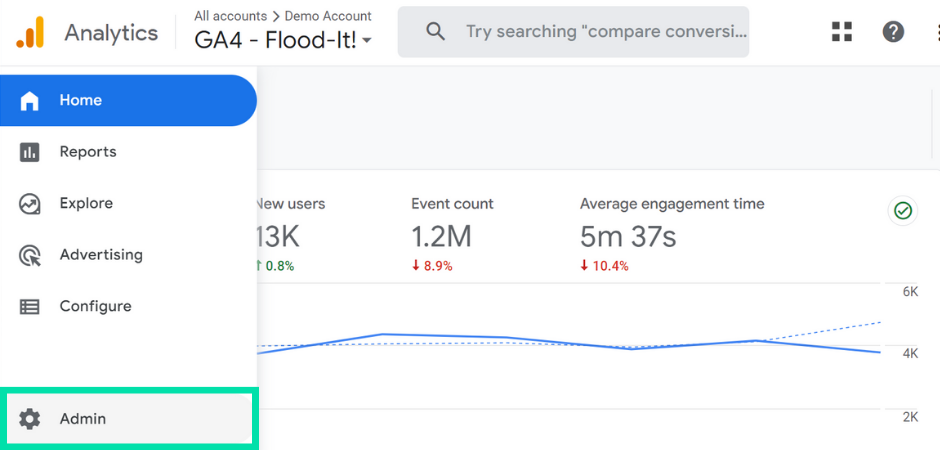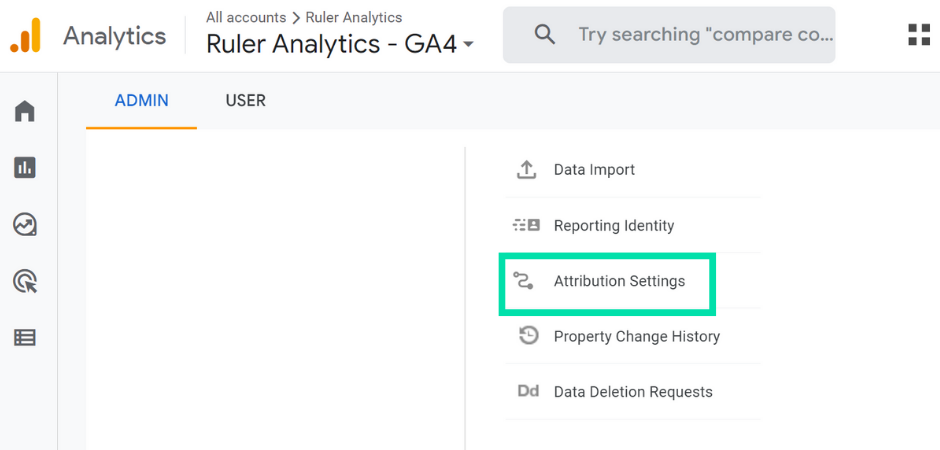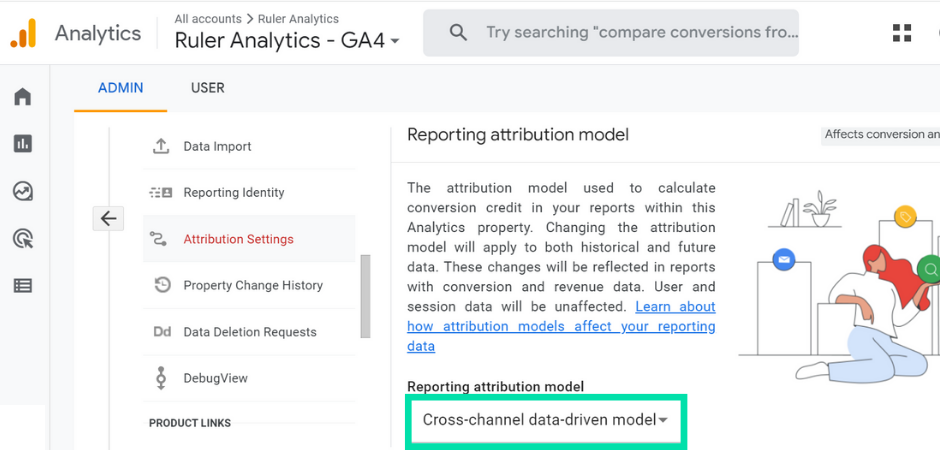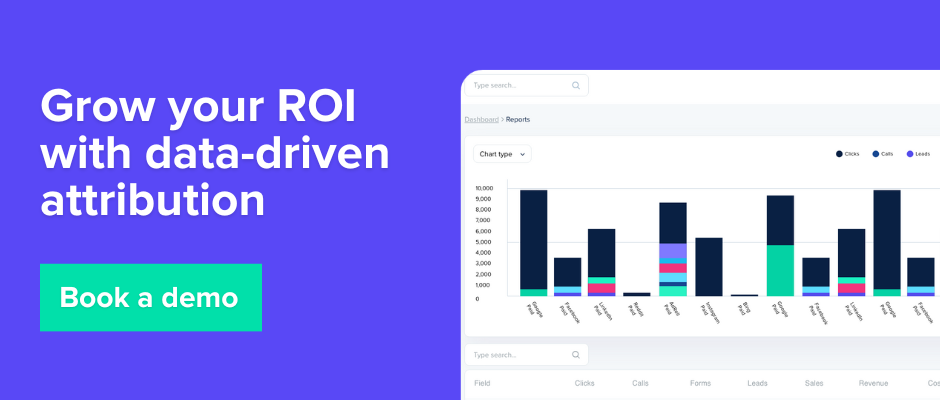Maximise your marketing and make better business decisions with data-driven attribution.
Attribution is a tool that marketers are slowly realising needs to be a major part of their marketing stack. According to Think with Google, 76% of all marketers say they currently have or will have in the next 12 months, the capability to use marketing attribution.
And it’s no surprise. Reporting on marketing is hard work.
When it comes to reporting, marketing has endless amounts of data.
And all the stats you want are siloed (aka you can’t link your revenue data in your CRM to your website data in analytics).
Then if you try to manually cross-reference that data, and you end up hitting a wall due to the tons of discrepancies you find, tool to tool. So much so, that 40% of marketers believe that more accurate data would improve the performance of their marketing.
In this blog, we’re going to dig deep into data-driven attribution so stick around to learn:
💡 Pro Tip
Chances are you’re here because you’ve considered using data-driven attribution. If so, why not give Ruler Analytics a try? Ruler offers data-driven attribution to give you the bigger picture and helps you identify the factors that affect your sales, deals and ROI.
Book a demo to learn more
Data-driven attribution is where a tool will assess and analyse customer behaviour to identify patterns among those users who convert, compared to those who don’t.

Google offers data-driven attribution within both Google Ads and Google Analytics. These tools will compare the customer paths of those who do and don’t convert to find patterns within their interactions.
💡 Pro Tip
You can also get data-driven attribution with our own tool, Ruler Analytics. Read more about how Ruler works and the data you can access here.
Data-driven attribution is a great option as it allows you to spot new trends in how users are engaging with your content and campaigns. Instead of having to analyse data yourself, data-driven attribution allows you to clearly see what’s working best and what isn’t.
Related: Complete guide to marketing attribution
You can select data-driven attribution as your chosen model type for conversions within Google Analytics and Google Ads to see how your marketing stacks up when it comes to driving new leads.
Let’s explore how each one works and what requirements you need to get the data in-app.
Data-driven attribution is a feature in Google Ads that allows you to credit conversions based on how people engage with your ads.

It analyses all of the data in your ad account to determine which keywords, ads and campaigns have the biggest impact on your bottom line.
Data-driven attribution looks at all engagements and interactions across your paid history to build a better understanding of how your ad campaigns work to drive conversions and sales.
Your data-driven model is specific to you and will allow you to:
With data-driven attribution in place on your paid reporting, you’ll see which ads have the greatest effect on your business goals.
And, if you use an automated bid strategy to drive more conversions, your bidding will use this important information to help you get more conversions.
Related: Guide to smart bidding on Google Ads
Sadly, not everyone will be able to access data-driven attribution as it does rely on a large amount of data in order to accurately predict trends.
Not all advertisers will see ‘data-driven’ as an attribution model type.
As a general rule, you need to have:
Because of the eligibility criteria, it’s possible that you’ll see data-driven attribution for some of your conversion actions, and not for others.
If you can’t access data-driven attribution, then Google Ads offer other attribution models that don’t have any data requirements gatekeeping them. These include:
And remember, the main issue with Google Ads is linking your lead generation to your closed revenue so you can see exactly which sales your paid advertising influenced.
If that’s the main problem you’re struggling with then read more on getting revenue into your Google Ads with offline conversion tracking.
If you hit the data requirements mentioned above, then you can get started with setting up your data-driven attribution model.
Here’s how to set it up:

3. In the table, select the conversion action that you want to edit
4. Click Edit settings.

5. Select Attribution model, then select Data-driven attribution from the drop-down menu.

6. Click Done, then click Save.
And that’s it! From there, it’s all set up and the data will start to roll in and attribute automatically.
Data-driven attribution is a machine learning-based attribution model in Google Analytics 4 that helps you understand the impact of your marketing channels and touchpoints on conversions.
It uses advanced statistical algorithms to analyse data from all the touchpoints along a customer’s journey to give credit to the channels that had the greatest impact on the conversion.
It looks at all the interactions that make up customer journeys, including clicks and video engagement on channels like:
It can link through data from all of your other Google products too, including Google Ads, Google Display and Campaign Manager 360.
In contrast to traditional attribution models, data-driven attribution takes a more sophisticated approach by using machine learning to analyse your data and determine the most impactful touchpoints.
To use data-driven attribution in Google Analytics 4, you need to have a sufficient amount of conversion data and touchpoint data in your account. Specifically, you need:
Here’s how you can enable Data-Driven Attribution for your account in Google Analytics 4:
1. Sign in to your Google Analytics 4 account and navigate to the property that you want to set up data-driven attribution for and click on Admin.

2. Navigate to Attribution Settings.

3. Data-driven attribution should be selected as your default model, but you can choose between more traditional rule based models such as last click, first click, linear.

4. If you scroll down, you can also go ahead and set your look-back window. Briefly, an attribution window is a time period during which a touchpoint is credited with contributing to a conversion. In the example, below we’ve chosen 30-days for acquisition conversion events and 90-days for all other conversion events.

Follow these steps correctly, and you should be good to go.
It’s worth keeping in mind that data-driven attribution is only available for certain types of conversion events in Google Analytics 4, such as e-commerce transactions and lead form submissions.
Also, data-driven attribution may not be accurate for accounts with low conversion volume or insufficient historical data.
While data-driven attribution in Google Ads and Analytics is less biased and helps distribute value between all touchpoints more fairly, it’s not perfect.
Here are a few limitations you need to be aware of:
While the limitations make the use of data-driven attribution impossible or unusable for some, you shouldn’t give up on it.
Data-driven attribution can help you gain valuable insights into the effectiveness of your marketing efforts, improve your ROI, and make more informed decisions about your campaigns.
And Google Ads and Analytics aren’t the only tools out there with data-driven attribution. There are many other tools available that allow for data-driven attribution tracking and more.
Take Ruler Analytics, for example.
Ruler’s data-driven attribution tracks and values all your marketing touchpoints through the Markov chain model.

Markov chains are used to model the customer journey and the impact of different marketing touchpoints in the conversion process.
The customer journey can be modelled as a sequence of states, where each state represents a particular stage in the journey (e.g. visiting the website, viewing a product, or adding an item to the cart.)
The Markov chain model is used to analyse the probability of transitioning from one state to another based on historical data and the impact of different marketing touchpoints on the transition probabilities.
The transition probabilities between states are represented by a transition matrix, which describes the likelihood of transitioning from one state to another. The transition matrix is calculated based on historical data and the impact of different marketing touchpoints on the customer journey.
Once the transition matrix is calculated, it can be used to assign credit to different marketing touchpoints based on their impact on the customer journey.
The credit assigned to each touchpoint is based on the difference between the transition probabilities with and without the touchpoint.
For example, if the transition probability from the “view product” state to the “add to cart” state is higher when a particular marketing touchpoint is present, then that touchpoint is assigned credit for the transition.
Once credit is assigned using DDA, you can:
We get that data-driven attribution is hard to understand, especially if you’re new to it all. If you want to get started with DDA but have no idea where to start, then book a demo with us here.
Data-driven attribution is a powerful tool for businesses looking to optimise their marketing campaigns and improve their ROI.
As technology continues to evolve, data-driven attribution will become increasingly important for businesses looking to stay ahead of the curve.
With the right data and tools, businesses can harness the power of data-driven attribution to make smarter marketing decisions and drive better business outcomes.
Ruler is one tool that uses data-driven attribution and can help businesses model the customer journey and assign credit to different marketing touchpoints more effectively.
Don’t just take our word for it. Book a demo and see it in action for yourself.
